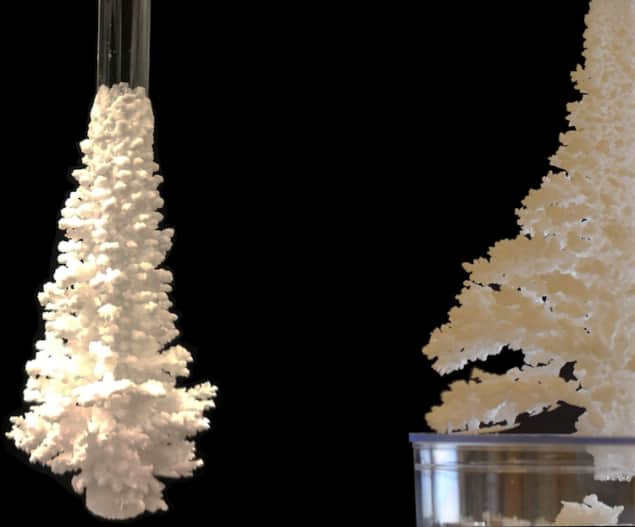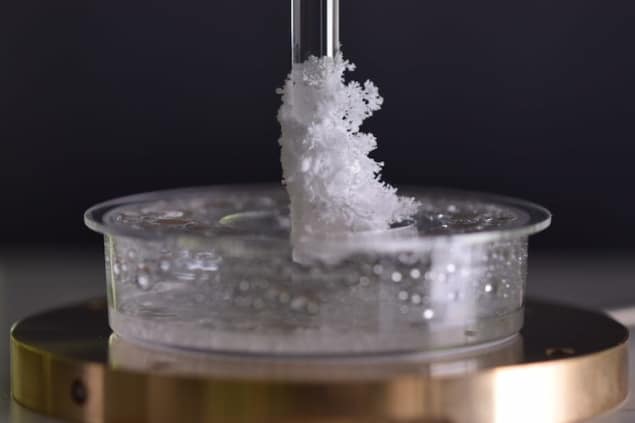
Salt creep – a common phenomenon that occurs when salt crystals rapidly precipitate from evaporating solutions – can create serious problems for outdoor electronics, buildings, artwork and agriculture because of its corrosive effect. A team of researchers from the University of Amsterdam in the Netherlands has now quantitively described the creeping mechanism for the first time, showing that it is most likely to occur when relative humidity is low and solution evaporating rates high. They also say that creeping, which they describe as a self-amplifying crystallization process, can be inhibited by adding non-ionic additives such as Tween 80 to a salt solution.
The salt crystals deposited during creeping can “climb” onto solid surfaces and spread quickly away from the evaporating solution. The phenomenon is fascinating because of the complex patterns it produces, but it is also a major nuisance in many practical situations, rapidly corroding even well-protected surfaces. Indeed, the speed at which the salt spreads is so fast that it has even been likened to superfluid helium flow.
Although the first research paper on salt creep was published nearly 100 years ago, few studies have probed the driving forces behind the initiation and rapid growth of salt crystals. A team led by Noushine Shahidzadeh has now provided a quantitative understanding of the creeping phenomenon thanks to a simple experiment.
High and low relative humidity
In their study, the researchers dipped a glass rod with a diameter of around 6 mm into four types of evaporating salt solution. The solutions they tested were sodium chloride (NaCl), potassium chloride (KCl) and two types of sodium sulphate: Na2SO4-A, which precipitates in the form of hydrated crystals, and Na2SO4-B, which forms anhydrous crystals.

They then left the solutions to dry in a chamber whose relative humidity (RH) they could control. At a RH of 40% and a temperature of 21°C, they did not observe salt creep on the rod for any of the solutions. Instead, the solutions became super-saturated with salt and crystals nucleated either in the chamber (for Na2SO4-B) or at the liquid/air interface (for NaCl, KCl, and Na2SO4-A). These latter crystals subsequently grew and fell into the bulk solution, where they continued to grow. The solution then detached from the glass rod as the level of solution in the chamber dropped.
The situation is very different at lower humidity, however. At a RH of 6%, the researchers observed salt creep in all the salt solutions they studied. Before creeping starts, the solution first becomes saturated in salt, triggering crystal precipitation and growth in the chamber — as observed for a RH of 40%. As evaporation continues, though, creep begins to occur on the glass rod and new crystals start to precipitate at a specific angle of the liquid/air interface with the surface (substrate). Next, a chain of crystals forms and quickly moves up the rod in a chaotic fashion.
Self-amplified creep
The team monitored this cascade of crystal formation with two cameras. They also measured the total weight of the rod plus salt crystals over time. From this, they learned that creeping is self-amplifying: a deposited crystal induces the precipitation of two new ones, which in turn, produce four new ones and so on. The salt deposit grows exponentially, which explains why large distances can be covered at great speed. The result is a Christmas-tree-shaped pattern of salt, Shahidzadeh says.
Shahidzadeh and colleagues, who report their work in Science Advances, say they can control and even suppress creep by influencing the number of emerging crystals (that is, the branching of the crystallization pattern) and the size of the crystals. They did this for the NaCl-containing solution by using two different additives at very low concentration known to affect salt crystallization – namely cetyltrimethylammonium bromide (CTAB), which is cationic, and Tween 80, which is non-ionic. The cationic surfactant is a nucleation promoter and thus accelerates the rate of salt creep, while the non-ionic surfactant acts as a nucleation inhibitor and therefore completes the creeping.
Although CTAB attracts chloride ions and causes NaCl to precipitate out, accelerating the rate of salt creeping, Tween 80 continuously reduces the contact angle between crystals and the meniscus at the liquid/air interface so that it never reaches the critical angle required for salt creeping to occur.
Controlling salt spread
This strategy could come in useful in four major domains, Shahidzedah tells Physics World. The first of these is civil engineering. Salt crystallization is one of the major causes of damage to stone and ceramic artefacts such as historically important buildings. This is because salt can transport out of the mortars employed (typically producing ugly white spots) and speed up corrosion, she explains. Another potential application lies in preventing salt from coming out of the stones that frescoes are painted on, to prevent blistering of the paint, she adds. “The recent disastrous flooding in Venice will probably induce a lot of salt crystallization and creeping on the artworks and frescoes of the city in the future.”
The third area of interest is electronic devices, since salt creep greatly limits the lifetime of outdoor electronic equipment.

Sistine Chapel artworks seen in a new light
A final area where mitigating salt creep could make a difference is agriculture. Underground salt deposits can migrate to the soil surface by creeping, which renders the soil infertile if present in high amounts. In parts of Senegal, for example, fresh water sources have almost disappeared because of drought. Evaporation leaves behind salty remnants, and these spread to nearby territory via salt creep.
A similar problem occurs in some forests and farmland in low-lying areas of North Carolina, on the US east coast. As in Senegal, salt seeps into these areas from the nearby ocean, leaving plants unable to grow as the soil is literally eaten away by salt. As the climate warms and sea levels rise, salt water will advance even further. Finding ways to slow down salt creep will thus be vital for communities in these and other similarly-affected regions.



